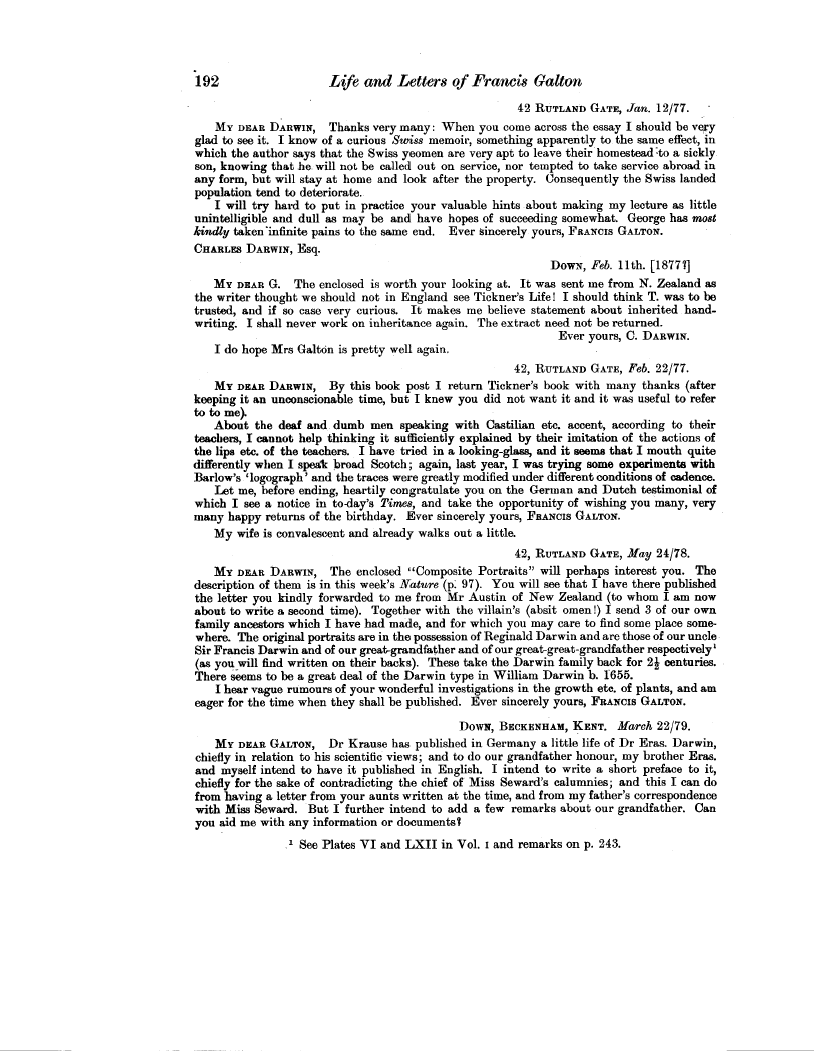192 Life and Letters of Francis Galton
42 RUTLAND GATE, Jan. 12/77.
MY DEAR DARWIN, Thanks very many: When you come across the essay I should be very glad to see it. I know of a curious Swiss memoir, something apparently to the same effect, in which the author says that the Swiss yeomen are very apt to leave their homestead.to a sickly son, knowing that he. will not be called out on service, nor tempted to take service abroad in any form, but will stay at home and look after the property. Consequently the Swiss landed population tend to deteriorate.
I will try hard to put in practice your valuable hints about making my lecture as little unintelligible and dull as may be and have hopes of succeeding somewhat. George has most kindly taken' infinite pains to the same end. Ever sincerely yours, FRANCis GALTON.
CHARLES DARWIN, Esq.
DowN, Feb. 11th. [1877?]
MY DEAR G. The enclosed is worth your looking at. It was sent me from N. Zealand as the writer thought we should not in England see Tickner's Life! I should think T. was to be trusted, and if so case very curious. It makes me believe statement about inherited handwriting. I shall never work on inheritance again. The extract need not be returned.
Ever yours, C. DARWIN.
I do hope Mrs Galton is pretty well again.
42, RUTLAND GATE, Feb. 22/77.
MY DEAR DARWIN, By this book post I return Tickner's book with many thanks (after keeping it an unconscionable time, but I knew you did not want it and it was useful to refer to to me).
About the deaf and dumb men speaking with Castilian etc. accent, according to their teachers, I cannot help thinking it sufficiently explained by their imitation of the actions of the lips etc. of the teachers. I have tried in a looking-glass, and it seems that I mouth quite differently when I spew broad Scotch; again, last year, I was trying some experiments with Barlow's `logograph' and the traces were greatly modified under different conditions of cadence.
Let me, before ending, heartily congratulate you on the German and Dutch testimonial of which I see a notice in to-day's Times, and take the opportunity of wishing you many, very many happy returns of the birthday. Ever sincerely yours, FRANCIS GALTON.
My wife is convalescent and already walks out a little.
42, RUTLAND GATE, May 24/78.
MY DEAR DARWIN, The enclosed "Composite Portraits" will perhaps interest you. The description of them is in this week's Nature (p. 97). You will see that I have there published the letter you kindly forwarded to me from Mr Austin of New Zealand (to whom I am now about to write a second time). Together with the villain's (absit omen!) I send 3 of our own family ancestors which I have had made, and for which you may care to find some place somewhere. The original portraits are in the possession of Reginald Darwin and are those of our uncle Sir Francis Darwin and of our great-grandfather and of our great-great-grandfather respectively' (as you will find written on their backs). These take the Darwin family back for 21 centuries. There seems to be a great deal of the Darwin type in William Darwin b. 1655.
I hear vague rumours of your wonderful investigations in the growth etc. of plants, and am eager for the time when they shall be published. Ever sincerely yours, FRANCIS GALTON.
DOWN, BECKENHAM, KENT. March 22/79.
MY DEAR GALTON, Dr Krause has published in Germany a little life of Dr Eras. Darwin, chiefly in relation to his scientific views; and to do our grandfather honour, my brother Eras. and myself intend to have it published in English. I intend to write a short preface to it, chiefly for the sake of contradicting the chief of Miss Seward's calumnies; and this I can do from having a letter from your aunts written at the time, and from my father's correspondence with Miss Seward. But I further intend to add a few remarks about our grandfather. Can you aid me with any information or documents?
.1 See Plates VI and LXII in Vol. I and remarks on p. 243.

